This is 1 of 2 for blogs regarding Ironman Australia. This first blog is a pre-race tech/equipment blog for the fellow gear geeks out there or for those interested as to how truly neurotic I can become before an important event. I mean it when I say to those readers who are not interested in triathlon equipment to save yourself losing precious minutes of your life and stop reading now. Please do me the honour of reading my second blog which will hopefully be of more general interest, completely over analysing my preparation and mental state for the lead up and during Ironman Australia if it goes poorly, or under analysing if I do well.
Professional triathletes tend to fall into two categories – ‘over thinkers’ and ‘under thinkers’. Both can have success and both can derail races either because an athlete does not considering their equipment choices for an event enough or as I’ve often done, completely over considering what equipment I’m using and tinkering to the point of wasting way too much energy and causing unnecessary stress leading into an event.
I’ve had a long running joke with Tim Berkel about how many times I can post the same picture pre-race of all my race gear laid out on Instagram, the social media platform that destroyed humility. Strangely, a pre-race gear spread pic seems to be well ‘liked’ even when it’s almost a complete replica of a few weeks prior. Despite that, I can’t bring myself to do the same shot for the 15th time so I thought I would do a quick write up with what I’ve chosen to use at Ironman Australia, delving a little into my insanity behind some of my decisions. For those that read pros blogs about sponsored items with scepticism I can understand that, however as with prior blogs, if I don’t like an item a sponsor of mine makes, I simply do not mention it. Also, not all the items below are sponsored items.
Saucony Kinvara 8, Freedom or Zealot Iso?
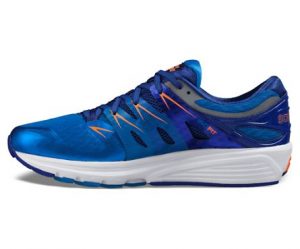
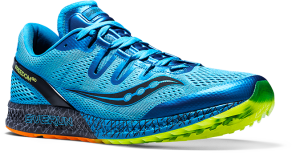
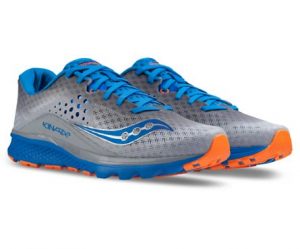
I’m on the low end of milage for a pro triathlete as I feel that for me, consistency pays greater dividends over sidelining injury. Because of that and minimal pronation for a natural biomechanical cushioning, I require more cushioning then what an athlete with consistent 100km + run weeks behind them might be able to compete in.
The Freedom was a late entrant to the shoe contenders. It’s unlike any other Saucony shoe I’ve run in with a super minimal sock-like upper and a very cushioned but fairly sole. I just didn’t have time to give this shoe enough testing on my long runs so I ruled it out purely because the shoe and I simply haven’t built up enough trust just yet. One thing I did notice was that while a lot of the Saucony shoes list the drop (forefoot to heel height differential) as 4mm in practice this drop can range quite a bit due to the cushioning of the sole. For example the Freedom in practice feels much closer to 1-2mm drop while the Kinvara feels closer to a 5-6mm drop. For now I’ll keep using the Freedom for my slower runs until our flirting has progressed to next base.
The Kinvara was the shoe that got me hooked on Saucony before we began working together several years ago while the Zealot Iso is a shoe that I first started for my higher milage weeks leading into Ironman Australia last year. Now I’m torn as to which shoe I prefer for longer duration sessions. The Kinvara is slightly quicker and responsive while the Zealot Iso a little more plush taking the sting out of the latter kilometres of the marathon. I completed several 2+ hour runs in both. I prefer the Kinvara for the first 25kms but after 25kms on tired legs, the Zealot really comes into own for comfort. Obeying the principle of sticking with what has worked I’ve decided to go the Zealot Iso again for Ironman Oz.
Trek Speed Concept 9.9
The time trial bike design that so many other companies are still trying to catch up to and replicate. It’s aero, adjustable, light and looks stunning especially with Project One customisation. It’s the engineering details that really get me drooling; Aero integrated brakes that actually work and are easily adjusted, a front end cockpit with literally hundreds of set up options and triathlon specific storage with no aero penalty. It’s been love since first ride. A love that has not faded in the slightest.
Draft Box Contents 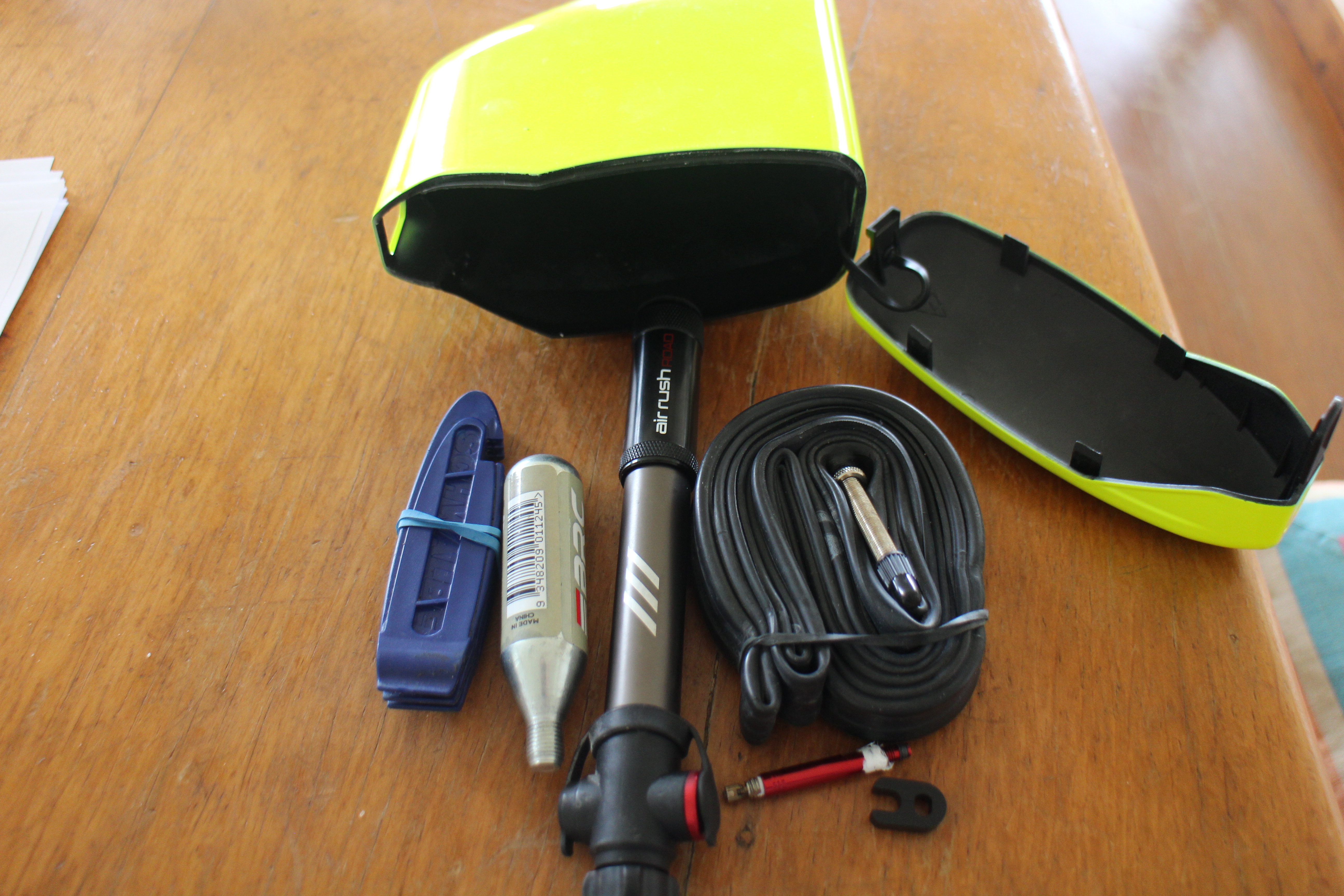
- Bontrager Air Rush Road Co2 Pump
- Co2
- Spare Tube
- Tyre Levers x 3
Groupset:
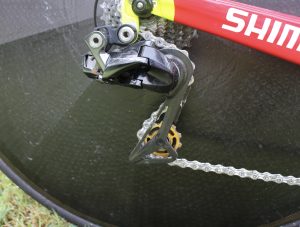
- Rear Derailleur- Shimano Dura Ace 9100
- Pulley Wheels- Ceramic Speed
- Bottom Bracket- Ceramic Speed
- Chain- Shimano Dura Ace with Ceramic Speed Coating
- Shifters- Shimano Dura Ace 9100
- Pedals- Shimano Dura Ace 9000
- Cassette- Shimano Dura Ace 9000 28/11
- Crankset- Shimano Dura Ace 9000 55/42 chain rings with Quarq Elsa RS- 162.5 length cranks.
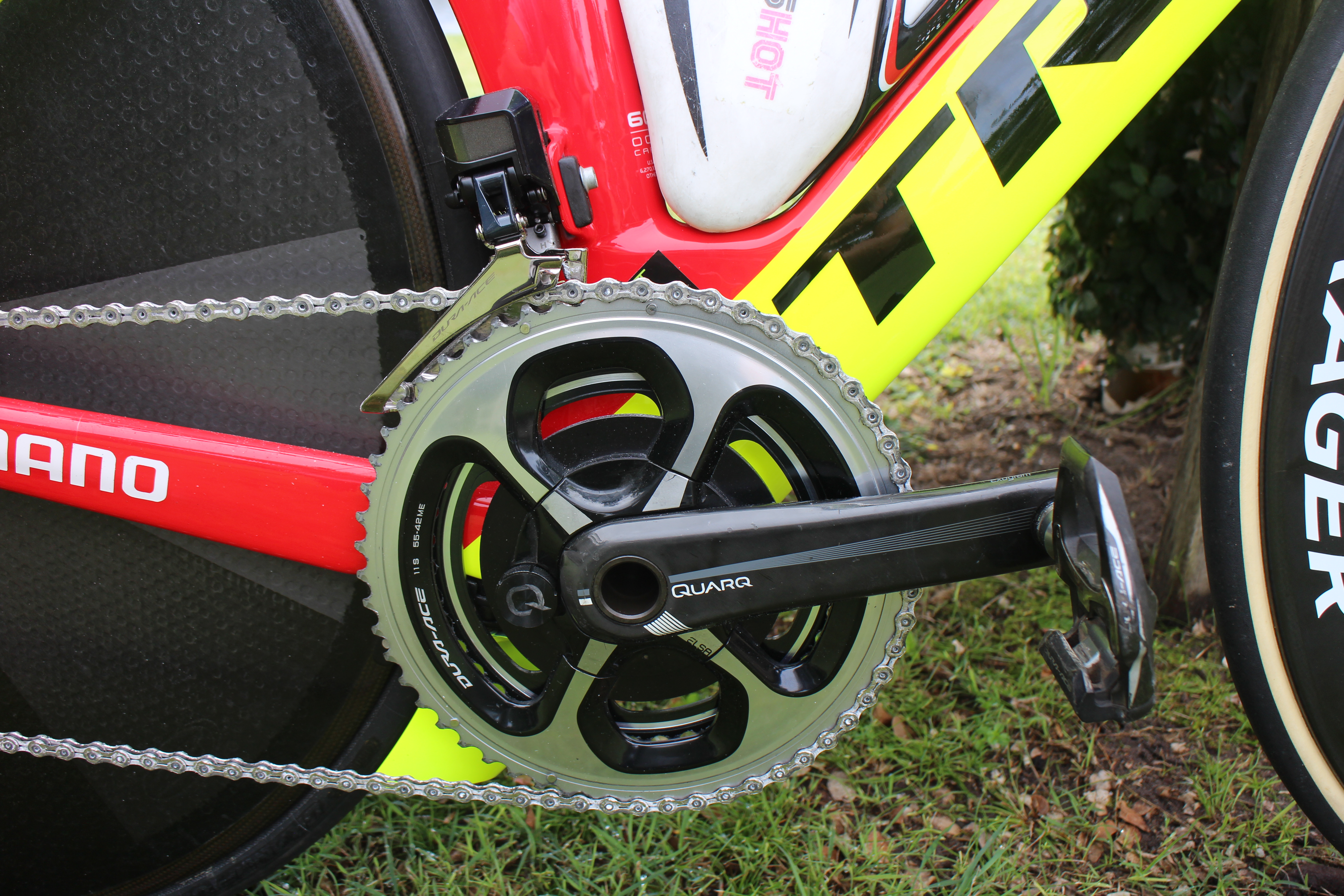
Budgy Smuggler, Sleeved Suit or Sleeveless Tri Suit?
Saucony have had Louis Garneau make several suits as options for racing the past few years. From other people’s aero testing the sleeved suit seems to test somewhere between 3-6 watts faster then the sleeveless options. Although I’m not sure the aero testing matches up in the real world where people come out of the swim and the sleeved suit is wet and wrinkled. Still, a potential aero benefit is available. The main reason I will ride in a sleeved suit is primarily for warmth. Port Mac can be pretty chilly until about 9 or 10am in May and a cold gnome is a slow gnome.
A few might recall when I gave left jab at Lionel Sanders for wearing Budgy Smugglers in Kona. I did this for a few reasons. He is a very emotional guy when it comes to triathlon and I thought it might really wind him up and create some good social media banter. He failed to fire back as he promised so it wasn’t as fun as it could have been. The second reason is where I as I feel like I can only truly peak for 3 races a year, Lionel’s energy, determination or perhaps straight up talent means he seems to be incredible for nearly year round. He doesn’t need to dress half naked like me to gain extra value for my sponsors. The third and most important reason is that I believe in hot races the minimal man bra offers a significant advantage on the run as it’s much cooler to not have the thighs covered in material and if there was anyway of shooting down any other athletes from also gaining that advantage then I’m going to try me best to do so. So, given the marathon could be quite warm, I’ll be doing a full change in transition into smugglers and a tri top.

Nutrition
I don’t want to give away too many secrets here as I don’t have a current sponsorship relationship with a nutrition company and after a lot of issues in the past, I’m really hoping that my nutrition strategy that’s been working really well for me in races and training continues to do so. It took a lot of 6-7 hour sessions before Ironman Australia last year to work out what works for me so I don’t want to give away that information for nothing. Additionally what works for me might be very different as to what works for you as everyone’s gut and caloric requirements are highly individual largely depending on how efficient the athlete is as utilising fat for fuel at sub threshold intensities.
On the run in particular, I experimented with all different concentrations of calories, electrolytes and quantities. What I did find is that relying on my thirst response to have successful long runs at race pace off the bike does not work for me as by the time I get really thirsty I’m already litres down on where I seem to be able to maintain the correct intensity. I’m either not thirsty at all until it’s too late and then I’m so thirsty later on that I shut my absorption down my having too much too quickly. So, I’ll stick to a schedule that I’ve found has worked in training and not rely on my thirst response as many respected sports scientists recommend.
With a particular unintentional positive doping test of a triathlete quite recently, I’ve become even more careful with what supplements I take. I pay full price for and have taken First Endurance Multi V Pro during this preparation. Unlike many multi vitamins the absorbability of the vitamins minerals is in an optimum form. It’s not cheap but quality rarely is. Touch wood, for the first time, I haven’t been sick once this Ironman prep aside from some food poisoning for a couple of days. Of course this could coincidence but worth mentioning.
As a side note, I’ve always argued for life bans for athletes for clear cut cases of cheating but now I also would really push regulators to have much stronger punishments for food and sports nutrition companies who’s products are found to have other ingredients in them other than what’s disclosed.
HOTSHOT
My battle with cramping is well known. There are many potential causes with two common causes including an electrolyte imbalance and straight up muscular fatigue. Ultimately though all causes lead to the same issue; an overstimulated nervous system that causes misfiring signals to the muscles. Preventing and treating the symptom of this; cramping, is where HOTSHOT is really something. An electrolyte imbalance is an easier one to solve. 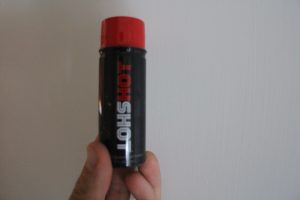 Conditioning your muscles to the required load of Ironman racing is more difficult because we are limited by how much training we can absorb without getting injured, sick or overly fatigued. Last year I first started cramping at 25kms despite sticking very diligently to my hydration and electrolyte plan.
Conditioning your muscles to the required load of Ironman racing is more difficult because we are limited by how much training we can absorb without getting injured, sick or overly fatigued. Last year I first started cramping at 25kms despite sticking very diligently to my hydration and electrolyte plan.
I had one bottle of Hotshot with me which I consumed. Within a minute all cramping ceased and I was able to run another 9-10 kms cramp free before the HOTSHOT effect seemed to wear off and I was forced to stop several times in the final few kilometres. So my simple adjustment for this year that will hopefully allow my final 10kms of the run to more in line with the my first 31km pace is that I’ll take several bottles with me on the run course. I’m yet to find anything that is as efficacious at keeping my overexcited misfiring nervous system settled down.
Breakfast
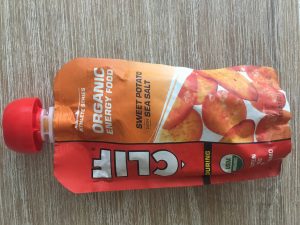
Roka Maverick X Wetsuit and Roka R1 Goggles
Hands down, or should I say with arms up (jajajajaja), easily the best wettie I’ve worn to date! The only wetsuit I’ve been able to wear the correct small size and not feel like my stroke is restricted.
In the same way in which Roka designed the Maverick X in a different way to everyone else, they did the same with the R1 changing the angle of the lense to greatly improve a swimmers upward range of view. Perfect if you’re like me and chasing feet the whole swim.

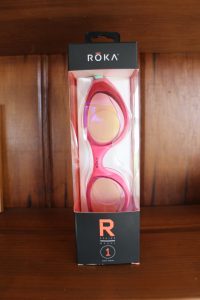
Bontrager XXX Road Shoes VS Aero Tri Shoe Vs Hilo RXL
I flat out love the XXX road shoe. I train it when I’m on my MTB, cross, time trial or road bike. I did race the Hilo RXL for quite a few races last year to get maximum seconds out of transition. A great tri shoe but tri shoes just never quite have the same feel as a road shoe in my opinion. Bontrager kindly made me a prototype aero shoe that I rode at Oceanside 70.3 last year and really liked and will likely use for Ironman 70.3 Cour d’Alene in June. In the end for 180kms of pedalling I’ve chosen comfort over aerodynamics and a super fast transition.
I did decide to change the fastening system to an elastic loop for a quicker transition. I consider this a stroke of genius while everyone else thinks I’ve ruined perfect shoes. The rubber band fastening works for me because the shoe fits so well I could almost ride it undone but I wouldn’t recommend you trying it with your pair at home. Point of information, these shoes come with a solid price tag, however they’re really built to last. This shoe is two years old, has completed 10-15 hours of cycling each week and been dragged through a lot of transitions and is still going going strong. It’s a worth every dollar.

Position
As a kid I rode my Dad’s MTB to commute around . Then in my first 3 years of triathlon I rode an oversized road bike with clip on tri bars. I learnt to ride a very slack seat angle because of always being on bikes too big for me but then continued to do so even when I was given frames the correct size. For a long time I just ignored advice because it was working. However bike fit experts I’ve talked to tend to agree that I’m riding solid in spite of a bad position certainly not because of it and with my back increasingly giving me grief and the cycling continuing its trend of persistently getting faster I’ve finally decided to start taking some advice on my position and have a bike fit scheduled with Ryan from 3D bike fit next week and then will follow up with Trek’s bike fit gurus ‘Cylcologic’ in Phoenix, Arizona later in the year. Don’t get me wrong, the ‘car park bike fit’ conducted on Instagram was a small step in the right direction but the time has come for me to get a hell of a lot more professional in the bike fit department.
Wheels and Tyres..
Wheels and tyres are my thing and where my ‘overthinking’ can run rampant. Some meandering before I get to my deliberating decision.
Weight Does Matter: Some companies will have you believe that weight no longer matters. The marketing convinced me of this opinion too until I noticed that on a lot of the hillier courses, in particular the 2015 Ironman 70.3 World Championships, it was the heavier triathletes who counter-intuitively rode the big climbs much more successfully than the smaller guys. The reason was perhaps at least partly because a time trial bike + 3-4 bidons of water + disc wheel+ spare is a hell of a lot higher percentage of a small athletes weight than a bigger athlete.
The common thinking is that weight only really matters if it’s a summit top finish because the extra weight provides an equal advantage on the descent. This isn’t true as regardless of your weight, riders are often limited to how fast they can go down the hill by the technicality of the descent or even if the athlete can pedal the downhill strongly, the high speed means that aerodynamic drag becomes the exponential limiting factor on speed so weight is less relevant on the descent than on the ascent.
My suspicions were confirmed in my own head when a blog at Terrain Dynamics, the creater of the ‘Air Hub’ of which I’m a big fan, more eloquently explained the above. Check it out here- http://terraindynamics.com.au/the-lab/the-math-doesnt-add-up
Why then, do the best climbers in the pro peloton tend to be extremely light riders? It’s a tough one to answer but my best bet is that these riders have the best power to weight ratio of the peloton that even overcomes the extra percentage of bike load a lighter rider has to take up hill. Which explains why many of the top climbers also can be very strong time triallists. So for SOME courses, weight still matters especially for smaller athletes while, for bigger athletes I wouldn’t be as worried about a half kg here or there.
How does this relate to wheels, well, perhaps to seemingly contradict myself, while Port Macquarie has a few short steep climbs, the majority of the course very moderately undulating and the road surface about as rough as you’ll race lending itself to the benefits of a wider contact patch that clinchers can provide on wide rimmed wheels. So saving 300-500 grams via a lighter wheel set such as the Bontrager Aeolus 9 tubular rear and 5 tubular front is likely countered by the clincher benefits.
I’m weird enough to bother doing rolling resistance testing of all my potential race tyres on my rollers. For Port Mac I was undecided as to whether to run tubeless, tubular or a clincher set up. I’ve tested enough tyres that I know out on the road that more and more tyres are joining the ‘fast crew’ that all roll pretty similarly however there are lot of other differences to be considered beyond how fast they roll before making your choice including including grip, durability, puncture resistance and more importantly for triathletes than cyclists- their aerodynamic characteristics.
‘Continental’ have stuck to their guns that tubeless tyres are not a necessary move in road cycling while most of the other tyre companies including Bontrager, Schwalbe, Hutchinson and now Vittoria are offering tubeless options. Continental, As a German company likely riding on silky smooth German hot mix are not considering us poor Aussies who after riding on Aussie roads are gluing teeth back in post ride. I really enjoy riding tubeless tyres in training, as I can run 60-70 psi without issue on really bad roads and drop even lower if I decide to mix in some off-road terrain. All that being said, I soon ruled out running tubeless at Port Mac because if the sealant doesn’t plug a puncture, it’s much harder to replace a tube then with it’s traditional clincher cousin.
To make the choice more difficult I’ve come across a tubular option that was quite a bit faster than anything I had tested. Slightly irrelevant information but typically to get a clincher and tubular tyre of the same tyre to match up in rolling resistance you need to run a 25mm tubular to match a 23mm clincher because the clincher, especially on a wider rim has a much wider contact patch.
In other words it’s effectively a much wider tyre than what it is specified to be. However this particular 23mm tubular was faster than even the fastest of the 25-28mm clincher tyres I’v tested! The results didn’t match up with other people I know of who test tyres but that’s not uncommon. Particularly among cotton casing tyres there can be some variation in tyre performance due to tyre construction, gluing procedure and the type of glue used. I was intrigued. Perhaps I had stumbled across a rogue beauty as I know other testers have found where an individual tyre stands apart even from other models of the exact same tyre. I even glued the same tyre to a different wheel and it was still faster than anything I’de trialled. I couldn’t resist doing some field testing and much to Berkel’s dismay I enlisted him to help me do some outdoor loops on a Port Macquarie like roads swapping wheels and recording times at a set power.
As I often find with field testing, the results were not nearly as significant as I imagined. The tyre was faster but after 80 minutes of testing it was not convincing enough to have to use it. Importantly I did notice, that I found my usual clincher set up felt the vibrations of the road a lot less at the same pressure. Over 180kms that extra comfort would be important. So given my concern of punctures at Ironman Australia and wanting to minimise vibrations, I’ll run a clincher set up and again choose comfort over speed. Of my clincher tyre selections I’ve gone for a set up with reasonable puncture resistance. While there are faster options I would use in other races for this event I would prefer to not risk wasted time dealing with a puncture. Of course that’s no guarantee I won’t get one.
Fear not old school racers, tubulars certainly aren’t dead. Hilly races with smooth surfaces and low cross winds which are all conditions where tubulars excel, I’ll be back on a tubular set up.
Depending on the forecasted wind, I’ll run an Aeolus 5 or Aeolus 7 front wheel. In the wind tunnel the stronger the cross wind/ higher yaw angle, the greater the aero benefit for a deeper front, however in practice, the greater the cross wind the more energy is spent keeping your bike in a straight line which quickly trumps the aero perks and shallow becomes a smarter move. Both wheels are very stable for their depth and combined with silky smooth DT-Swiss hubs I’ll be surprised if anyone can produce valid testing showing faster wheels of the same depth.
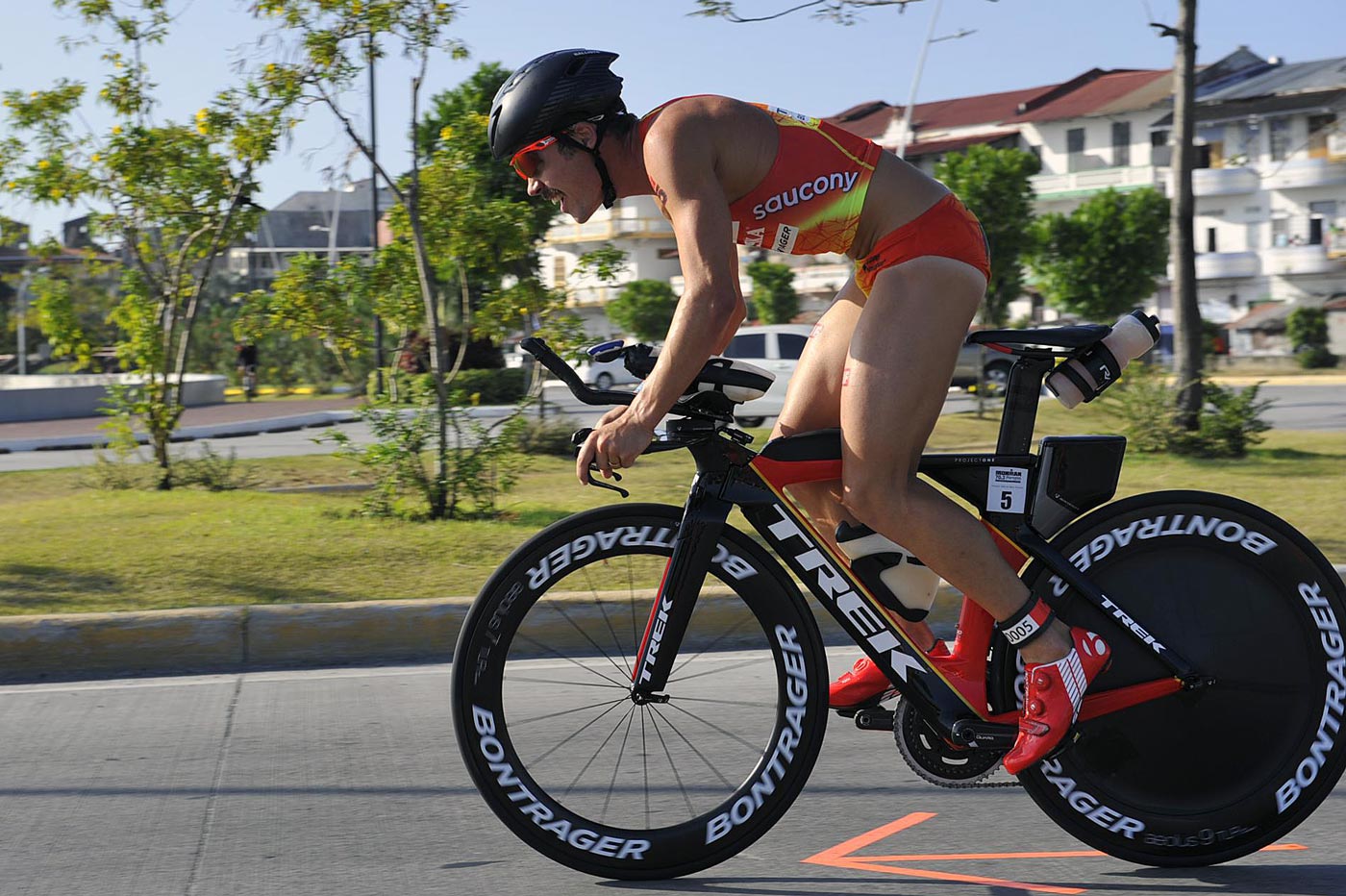
Helmet- Bontrager Aeolus or Bontrager Ballista?
The full time trial styled ‘Aeolus’ is faster in a certain fixed position. If was a pro tour rider completing a 20km TT this 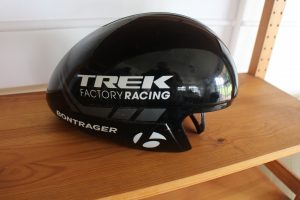 would be my go to. Additionally I’ve worn it in races primarily to stay warmer rather than in an effort to find free speed even though a few watts are available.
would be my go to. Additionally I’ve worn it in races primarily to stay warmer rather than in an effort to find free speed even though a few watts are available.
However the road helmet styled Ballista is aerodynamically versatile in a range of positions. It’s comfortable and 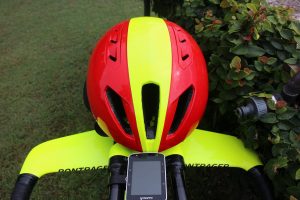 breathes superbly. An easy choice over 180kms of riding. Here is some independent testing proving it’s the business- http://www.bikeradar.com/au/road/gear/article/best-aero-road-helmets-tunnel-and-road-tested-44719/
breathes superbly. An easy choice over 180kms of riding. Here is some independent testing proving it’s the business- http://www.bikeradar.com/au/road/gear/article/best-aero-road-helmets-tunnel-and-road-tested-44719/
Hat- HOTSHOT Full vented trucker.
I asked HOTSHOT if they could get made a trucker that was full mesh and they delivered. Hard to get better breathability in a hat then that.

Sunglasses- Rudy Project Tralyx
I’ve been in Rudy Project since my 2nd year as a professional. The Tralyx stands out for me as their best time trial sunnies because of the adjustable nose piece that allows the sunnies to sit a little higher than you would have them running providing a full range of view without having to bring your head too far out of an aero tuck. Onto the run and a quick pinch of the nose piece and they’re sitting on your face normally.

Anti-Chafe
I get a lot of emails on this..The best that I’ve tried is Squirt Barrier Balm or Ruby’s Wax. Apply liberally and include some in your special needs bag for emergencies.
That’s about it. If you’ve made it this far without falling asleep and are racing on Sunday, all the very best!
 Please contact:
Please contact: